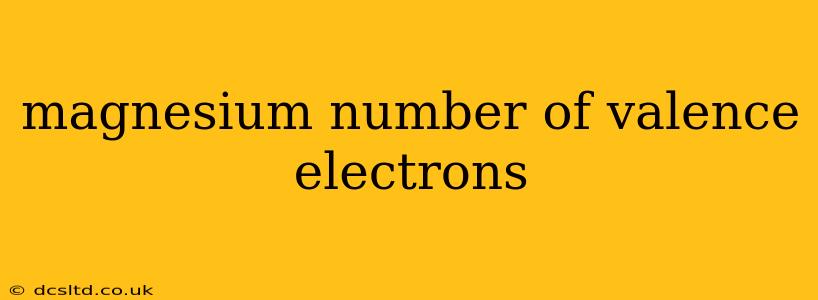Magnesium, a silvery-white alkaline earth metal, plays a crucial role in various biological and industrial processes. Understanding its electronic structure, particularly the number of valence electrons, is key to comprehending its chemical behavior and reactivity. This post delves into the fascinating world of magnesium's valence electrons, answering common questions and providing insightful information for students and enthusiasts alike.
How many valence electrons does magnesium have?
Magnesium (Mg) has two valence electrons. These are the electrons located in the outermost electron shell, also known as the valence shell. Its electron configuration is 1s²2s²2p⁶3s², meaning it has two electrons in its outermost shell (the 3s orbital). These two valence electrons are readily available for chemical bonding, making magnesium highly reactive.
What is the significance of magnesium's valence electrons?
The significance of magnesium's two valence electrons lies in its ability to form chemical bonds. These electrons participate in chemical reactions, determining magnesium's reactivity and the types of compounds it can form. Since magnesium readily loses these two electrons to achieve a stable electron configuration (like that of neon), it typically forms ionic bonds with nonmetals, resulting in compounds like magnesium oxide (MgO) and magnesium chloride (MgCl₂).
How does the number of valence electrons affect magnesium's properties?
The presence of only two valence electrons significantly influences magnesium's properties:
-
Reactivity: Magnesium's low ionization energy (the energy required to remove an electron) allows it to readily lose its two valence electrons, making it relatively reactive. This reactivity is evident in its tendency to burn brightly in air, producing a dazzling white light.
-
Conductivity: The loosely held valence electrons contribute to magnesium's good electrical and thermal conductivity. These electrons can move freely through the metal lattice, facilitating the transfer of heat and electricity.
-
Chemical Bonding: The two valence electrons dictate the type of chemical bonds magnesium forms. As mentioned, it primarily forms ionic bonds by losing these electrons to achieve a stable octet configuration.
What are some common compounds formed by magnesium?
Due to its two valence electrons, magnesium forms numerous compounds with various nonmetals. Some examples include:
- Magnesium oxide (MgO): Used in refractory materials, insulation, and as a dietary supplement.
- Magnesium hydroxide (Mg(OH)₂): A common antacid and laxative.
- Magnesium chloride (MgCl₂): Used in the production of magnesium metal and as a de-icing agent.
- Magnesium sulfate (MgSO₄): Known as Epsom salts, used in bath salts and as a laxative.
Why is understanding magnesium's valence electrons important?
Understanding the number and behavior of magnesium's valence electrons is critical for:
- Predicting its chemical reactivity: Knowing it has two valence electrons helps predict its tendency to form ionic bonds and its reactions with other elements.
- Explaining its physical properties: Its valence electrons explain its conductivity and other physical characteristics.
- Understanding its applications: Its chemical behavior, governed by its valence electrons, determines its diverse applications in various industries and biological systems.
In conclusion, the two valence electrons of magnesium are fundamental to understanding its chemical behavior, physical properties, and its various applications. This seemingly simple number holds the key to a deeper comprehension of this essential element.
